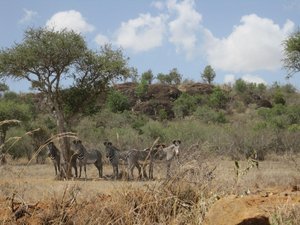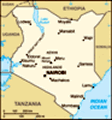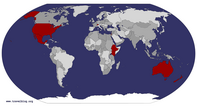Advertisement
Published: June 27th 2009

 Grevy group
Grevy group
Grevy's zebras are the endangered zebra species on Mpala. The other zebra is the plains zebra. Grevy's has much finer stripes and their stripes don't go that far down on their belly, giving them the appearance of very round, white bellies.A day in the life…
A friend asked me what my typical day out here was like and so here is the long version. Most of you field people will find this pretty familiar but bear with me.
My alarm goes off at 6:15, before sunrise. I am now in the habit of grabbing a Digestive biscuit (so good! And perhaps good for your digestive system) and a piece of Cadbury milk chocolate bar. This is the only place where I allow myself so much chocolate; I nibble on more of the bar during the course of the day. The British (i.e. Cadbury which is the only chocolate sold in the European-targeted groceries) know how to do milk chocolate right. I’m in the office before 7:00 checking my personal emails and facebook. I find I spend a lot more time on facebook here than I do back home but that’s likely because it’s my main form of communication here. Breakfast is btw 7:00-8:00 though is by no means strictly punctual. Only lunch is pretty punctual and that’s probably because of the pack of hungry researchers who always get back in time for lunch at 1:00. I’m out in the

 Ostriches!
Ostriches!
Male and femalefield from 8:00-12:30, jolting about in a beat-up, grey pick-up truck listening to the KLEE guys speak in Turkana. They always slow down for animal viewings and make sure that I get a good vantage for taking pictures. Everywhere I go, I have my camera and my binoculars. And I mean everywhere, just walking from the dining hall to the house I have them ready.
When I’m in the plots, I work by myself. There are protected plots with good fencing where the day-time worry of angry buffalo hiding under deep shade is at a minimum. As is the continual threat of large carnivores, really just lions during the day. There I can just be dropped off. Otherwise, in the unprotected plots, I have to make sure the KLEE guys are nearby. I walk around in 20m circles at regular intervals searching for Cadaba bushes and then at 11:00, I do butterfly surveys which also consists of circles, turning slowly in place and looking for butterflies. The flap of a bird wing or an unknown call always distracts me and so I am constantly peering about for new species.
Lunch-break is a must especially since all the field

 Marit hard at work
Marit hard at work
This is my "office." Note the biscuits less than a hand's reach away...assistants live at the village and want to go back for lunch. Some researchers would be quite happy to stay out past lunch but it’s just not what it is done. There are several long-held customs at Mpala that you just don't buck. After lunch, I stay in the office, attempting to answer work emails and do research for the projects back home. At 5:00, I check out and bird-watch, shower, and read until near dinner time. Before and after dinner-time is my play internet time, unless there’s sundowners or a game drive going on. Which happens frequently enough to keep my days from ever being too regular. 10:00 is lights out when all the lights shut off except the ones in the labs which then switch to battery and can run until the electricity comes back on around 6:45 AM. 10:00 is generally the researchers’ bed-time and little happens after that point unless there’s really a party going on.
There ya go! That’s been my life for the past two weeks and will be so for the next two ones. Except for the fact that I’m ahead of schedule with my project (when has that ever happened?!) and

 tree house
tree house
Sundowners at the tree houseso I might have some free mornings to help out with other people’s field work, go up in a plane with Kana who tracks wild dogs, and/or volunteer a day with the Mobile Clinic. Can’t complain!
Tree-house
Kathleen, a grad student from Univ of Florida, invited us to Sundowner at the house she’s renting. It’s off Mpala and is actually cheaper than Mpala accommodations. However, you have to have your own car and it’s a 45-minute drive. And considering how much time all of us already spend in the car since you have to drive EVERYWHERE here, that’s a bit of a haul. That being said, a visit out there is incredible. The house is permanently rented by a man named Laurence Frank who then temporarily rents out the guest house and another bedroom to researchers. The drive takes so long because the roads are so poor and I imagine when it rains they’re often impassable. But the road seems to just head off into the middle of nowhere and then all of a sudden there’s this tree house. The house sits on top of a low escarpment so that the first floor balcony hangs over a 30-m

 view from the tree house
view from the tree house
There's still a bit of water in the rivers around heredrop. Stone and wood almost intertwine in the walls and all the wall furnishings appear to emerge out of the rough-hewn stone. There’s a pair of tree hyrax (closest relative is an elephant but they sort of resemble a marmot) that gets fed by whoever is in the house. They set a platter of food in a tree which is level to the balcony and then the hyraxes emerge onto a boulder below and then clamber up the tree, munching away on pineapple and mango and looking fat and content. You can see all across the valley and can even make out the high-power lights of the flower greenhouses.
We dined on pineapple and chapattis and talked until well after the sun downed. On the way back, seven of us piled into Rita, one

 tree hyrax feeding
tree hyrax feeding
This is a terrible shot but my camera did not like the twilight hour. So you can see the food better than the hyrax but that lump with the bright eyes is the hyrax.of the many huge vehicles around this place, we saw a full-grown male lion cross the road, carrying something in its jaws! My first (for this trip) sight of a lion though, unfortunately, all I saw were the hindquarters. But they were pretty damn massive. We turned off the car, switched off lights, and (with the windows rolled up and the pop-top partially closed) waited to see if it would return, curious at this monstrosity. But it never did so eventually, after Stefan gave a few imitation lion huffs, we trundled along our way. On the main road, we had an excellent look at an aardwolf with its stripes and large, fox-like ears. Not a bad sundowners!
Animal updates
I would give much to have the back/frontyard view and wildlife action that I have here at the KLEE house. Early this evening, after a rather desultory afternoon, I was writing in my journal on the verandah. Unless I’m getting ready for bed or getting dressed or sleeping, I spend zero time inside the KLEE house. All my relaxation time is on the verandah, my binoculars and usually camera right beside me. As I was writing, I kept looking

 cramming into Rita
cramming into Rita
Meet Rita. She holds...many more people than she probably technically should. And yes, Renee did ride on top of the car pretty much the whole way home.up because I constantly was hearing wing flutter or some creature snuffling in the grass. Eventually it got so distracting I put aside my writing and just watched. A pair of red-billed hornbills landed in the grass. Dwarf mongooses with their oddly light eyes and tiny, eight-inch bodies emerged to scatter themselves across the grass and around the trees, poking, digging, bouncing. The male hornbill occasionally drove off a mongoose if it came to close but the female loudly flapped over to where one mongoose was rooting around in some dead wood. Practically over the mongoose’s shoulder, the hornbill snapped up grubs, bugs, whatever it saw crawling out of the wood. A red-fronted tinkerbird, small with stripes on its wings and deep red at the base of its tail, decided that a resting dik-dik looked like it would be a good place for a snack. The tinkerbird landed on top of the dik-dik’s head and poked around its eye, presumably for ticks, until finally the dik-dik had enough of this minor assault and got to its feet. The mongooses scrabbled everywhere, popping up occasionally on their hind legs if I made any big movement and giving out warning calls. Common

 Impala
Impala
What Mpala was named for. This is a male. The color contrast is not strong but you can see how sleek and pretty an animal it is. Its harem was just a little ways off.drongos, black-brown all over, flitted in the trees calling constantly. A dove landed and I focused on it with the binocs. Sure enough, it was the emerald-spotted wood-dove I’d seen two days earlier, all puffed up and with its shiny emerald wing decorations glowing in the slanting light. Finally, my legs started cramping under me so I shifted position. The mongooses shrieked and instantly disappeared and the dik-diks bounded off to a safer distance away. Most of the action had been taking place less than 10m away from me. What a great way to spend the end of an afternoon off!
Animal sightings
lion
red-fronted tinkerbird
red-billed hornbill
vitelline masked weaver
black-cheeked waxbill
Hadada ibis
ostrich
Advertisement
Tot: 0.115s; Tpl: 0.012s; cc: 11; qc: 45; dbt: 0.0559s; 1; m:domysql w:travelblog (10.17.0.13); sld: 1;
; mem: 1.2mb











